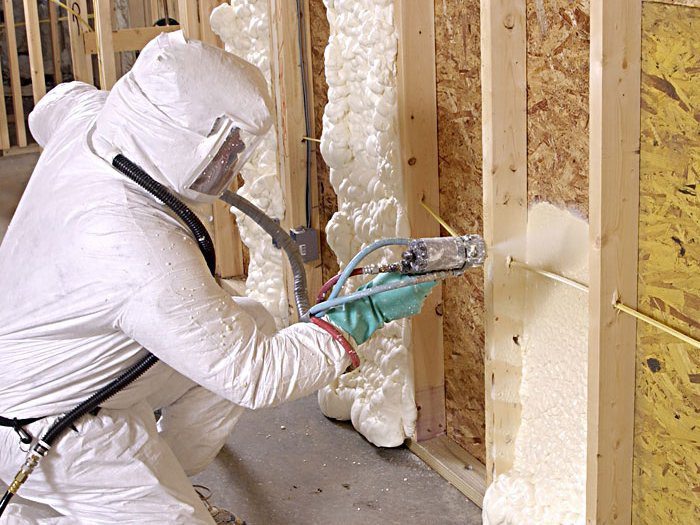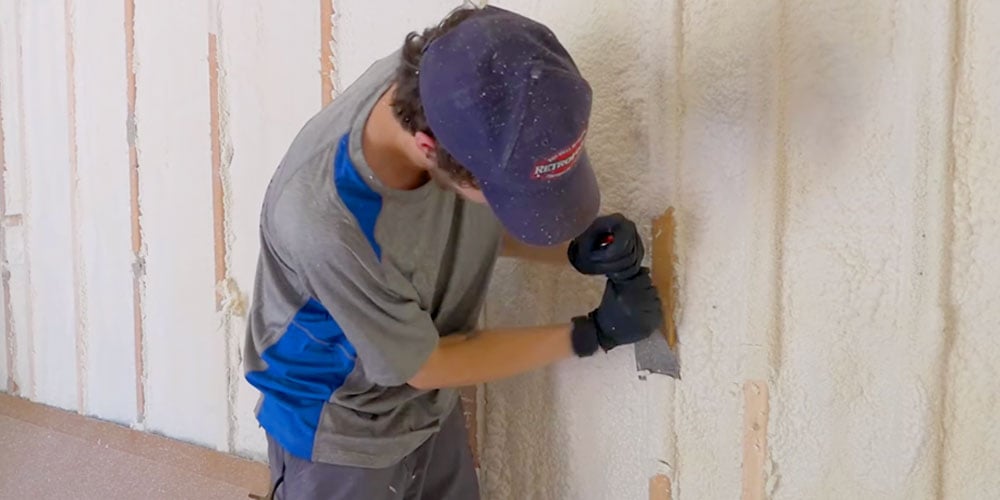The Process of Applying Spray Foam: What You Need to Know
The Process of Applying Spray Foam: What You Need to Know
Blog Article
Spray Foam: The Ultimate Service for Air Sealing and Insulation
Spray foam insulation has actually arised as a leading remedy for effective air sealing and thermal insulation, using a special mix of properties that establish it apart from standard techniques. Understanding the complete extent of its benefits, installment processes, and contrasts with various other insulation kinds is important for making notified decisions.
What Is Spray Foam?
Spray foam is a versatile insulation material that incorporates the principles of air securing and thermal resistance to enhance energy efficiency in structures. Made up largely of polyurethane or other comparable compounds, spray foam is used as a fluid that broadens upon contact with surfaces, producing a strong, continuous layer of insulation. This special home allows it to fill up spaces, splits, and spaces that conventional insulation materials may overlook, providing a remarkable air seal.
There are 2 major kinds of spray foam: open-cell and closed-cell. Open-cell spray foam is lighter and a lot more versatile, using excellent audio absorption and a lower R-value per inch - Spray Foam. On the other hand, closed-cell spray foam is denser, offering a greater R-value, moisture resistance, and added structural integrity to building parts
The application process commonly entails specialized devices, guaranteeing a smooth application that abides by various substrates, including timber, concrete, and steel. This versatility makes spray foam appropriate for both new buildings and retrofitting existing frameworks. Its capability to develop a closed barrier dramatically adds to minimizing power intake and enhancing indoor air quality, therefore making it a favored choice among contractors and property owners alike.
Benefits of Spray Foam Insulation
One of the most significant advantages of spray foam insulation is its extraordinary capacity to produce a continual air obstacle, which efficiently minimizes energy loss. Unlike standard insulation materials, spray foam expands to fill up gaps and splits, making certain that air leakage is significantly decreased. This particular not only boosts energy efficiency but also causes lower utility expenses gradually.
Furthermore, spray foam insulation provides premium thermal resistance, adding to a more steady indoor setting. Its high R-value per inch permits efficient insulation in confined areas, making it optimal for attics, walls, and crawl rooms. In addition, the moisture-resistant buildings of spray foam aid protect against mold and mildew and mold growth, promoting healthier living problems.
Another important benefit of spray foam insulation is its sound-dampening qualities (Spray Foam). It properly decreases noise transmission between rooms, developing a quieter and more comfortable home atmosphere. The resilience of spray foam also attracts attention, as it does not sag or settle gradually, preserving its performance throughout its lifespan
Just How Spray Foam Functions
Recognizing just how spray foam insulation works is necessary for appreciating its efficiency in air sealing and thermal resistance. Spray foam insulation is composed of 2 main parts: isocyanate and polyol material. When these components are combined, they undertake a chain reaction that causes the material to increase rapidly, developing a thick foam that loads cracks, dental caries, and gaps.
As the foam increases, it follows surface areas, forming an airtight seal that significantly reduces air seepage. This characteristic makes spray foam insulation highly effective at preventing drafts and moisture infiltration, which can cause energy loss and useful site damages gradually. In addition, the closed-cell version of spray foam offers exceptional thermal resistance as a result of its inflexible structure, efficiently decreasing heat transfer.
The distinct homes of spray foam enable it to comply with irregular surface areas, making certain comprehensive coverage and a smooth barrier. Therefore, spray foam insulation not just enhances power effectiveness but additionally hop over to these guys adds to enhanced indoor air high quality by lowering the accumulation of allergens and pollutants. Ultimately, understanding the technicians behind spray foam emphasizes its function as a remarkable selection for insulation and air securing in both commercial and residential applications.
Installation Refine Summary

Before installation, the room should be effectively cleansed and prepped, making certain that surface areas are without wetness, debris, and dust. Due to the fact that pollutants can endanger attachment and overall performance, this action is critical. When the location is prepared, the application involves blending the 2 elements of the spray foam, which increases upon call and fills gaps efficiently.
Educated specialists ought to conduct the setup, utilizing specialized equipment to ensure uniform coverage and optimal density. Safety and security safety measures, consisting of putting on protective equipment and making sure proper air flow, are imperative throughout this process. After application, the foam typically treatments swiftly, creating a strong obstacle that improves energy performance.
Comparing Spray Foam to Typical Insulation
When assessing insulation alternatives, spray foam insulation stands out in comparison to conventional materials such as fiberglass and cellulose. Unlike fiberglass and cellulose, which can enable air seepage, spray foam expands upon application, filling crevices and voids to develop an impermeable seal.
Furthermore, spray foam supplies a higher R-value per inch than typical insulation kinds, supplying even more reliable thermal resistance in a thinner profile. This particular is specifically beneficial precede with minimal dental caries deepness. Furthermore, spray foam is immune to wetness and mold growth, which can be a significant interest in cellulose and fiberglass, particularly in moist environments.
However, spray foam insulation commonly carries a greater in advance cost than its conventional equivalents. Homeowners should evaluate this initial financial investment against lasting power savings and efficiency advantages. Ultimately, while both insulation kinds serve their function, spray find out foam becomes an extra innovative remedy for contemporary insulation requirements, particularly in terms of air sealing and thermal efficiency.

Verdict
In recap, spray foam insulation represents a very effective service for achieving optimum air securing and thermal resistance. Its special residential properties, consisting of wetness resistance and sound dampening, make it appropriate for various applications in both new buildings and retrofitting jobs (Spray Foam). Although the first prices may be higher contrasted to traditional insulation products, the lasting benefits, such as considerable power savings and boosted indoor air high quality, warrant the financial investment and highlight its value in contemporary structure practices.
Spray foam insulation has actually arised as a leading solution for effective air securing and thermal insulation, providing a distinct combination of properties that set it apart from traditional techniques.Spray foam is a functional insulation product that integrates the principles of air securing and thermal resistance to boost energy effectiveness in buildings.When evaluating insulation options, spray foam insulation stands out in contrast to standard materials such as fiberglass and cellulose. Eventually, while both insulation kinds offer their objective, spray foam emerges as a more innovative service for contemporary insulation needs, specifically in terms of air securing and thermal efficiency.
In summary, spray foam insulation represents a very efficient service for achieving optimum air sealing and thermal resistance.
Report this page